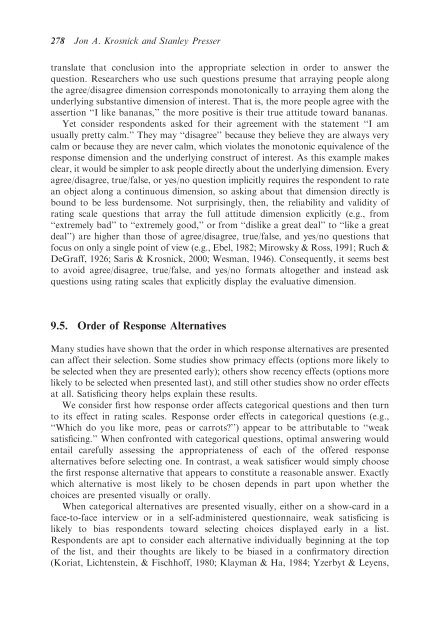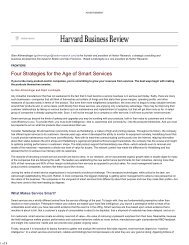Question and Questionnaire Design - Stanford University
Question and Questionnaire Design - Stanford University
Question and Questionnaire Design - Stanford University
You also want an ePaper? Increase the reach of your titles
YUMPU automatically turns print PDFs into web optimized ePapers that Google loves.
278 Jon A. Krosnick <strong>and</strong> Stanley Pressertranslate that conclusion into the appropriate selection in order to answer thequestion. Researchers who use such questions presume that arraying people alongthe agree/disagree dimension corresponds monotonically to arraying them along theunderlying substantive dimension of interest. That is, the more people agree with theassertion ‘‘I like bananas,’’ the more positive is their true attitude toward bananas.Yet consider respondents asked for their agreement with the statement ‘‘I amusually pretty calm.’’ They may ‘‘disagree’’ because they believe they are always verycalm or because they are never calm, which violates the monotonic equivalence of theresponse dimension <strong>and</strong> the underlying construct of interest. As this example makesclear, it would be simpler to ask people directly about the underlying dimension. Everyagree/disagree, true/false, or yes/no question implicitly requires the respondent to ratean object along a continuous dimension, so asking about that dimension directly isbound to be less burdensome. Not surprisingly, then, the reliability <strong>and</strong> validity ofrating scale questions that array the full attitude dimension explicitly (e.g., from‘‘extremely bad’’ to ‘‘extremely good,’’ or from ‘‘dislike a great deal’’ to ‘‘like a greatdeal’’) are higher than those of agree/disagree, true/false, <strong>and</strong> yes/no questions thatfocus on only a single point of view (e.g., Ebel, 1982; Mirowsky & Ross, 1991; Ruch &DeGraff, 1926; Saris & Krosnick, 2000; Wesman, 1946). Consequently, it seems bestto avoid agree/disagree, true/false, <strong>and</strong> yes/no formats altogether <strong>and</strong> instead askquestions using rating scales that explicitly display the evaluative dimension.9.5. Order of Response AlternativesMany studies have shown that the order in which response alternatives are presentedcan affect their selection. Some studies show primacy effects (options more likely tobe selected when they are presented early); others show recency effects (options morelikely to be selected when presented last), <strong>and</strong> still other studies show no order effectsat all. Satisficing theory helps explain these results.We consider first how response order affects categorical questions <strong>and</strong> then turnto its effect in rating scales. Response order effects in categorical questions (e.g.,‘‘Which do you like more, peas or carrots?’’) appear to be attributable to ‘‘weaksatisficing.’’ When confronted with categorical questions, optimal answering wouldentail carefully assessing the appropriateness of each of the offered responsealternatives before selecting one. In contrast, a weak satisficer would simply choosethe first response alternative that appears to constitute a reasonable answer. Exactlywhich alternative is most likely to be chosen depends in part upon whether thechoices are presented visually or orally.When categorical alternatives are presented visually, either on a show-card in aface-to-face interview or in a self-administered questionnaire, weak satisficing islikely to bias respondents toward selecting choices displayed early in a list.Respondents are apt to consider each alternative individually beginning at the topof the list, <strong>and</strong> their thoughts are likely to be biased in a confirmatory direction(Koriat, Lichtenstein, & Fischhoff, 1980; Klayman & Ha, 1984; Yzerbyt & Leyens,
















